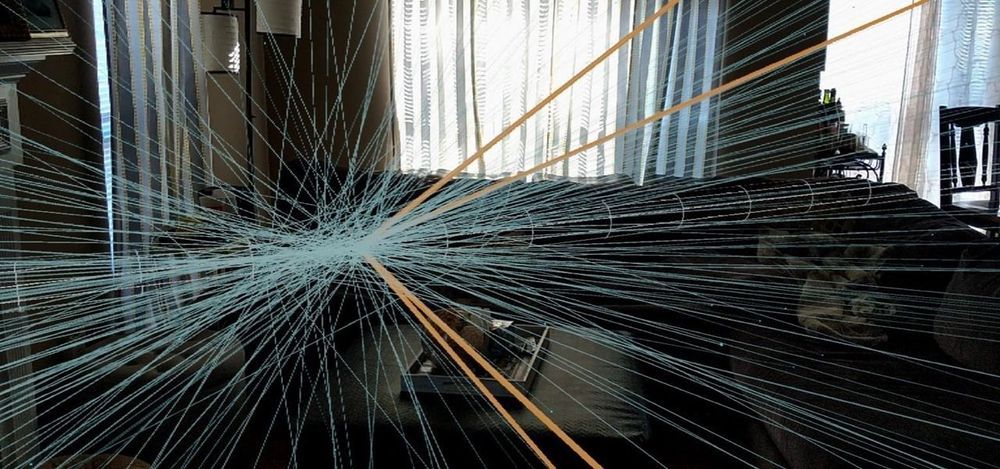Archive for the ‘particle physics’ category: Page 483
Jan 2, 2019
Cosmic Ray Showers Crash Supercomputers. Here’s What to Do About It
Posted by Genevieve Klien in categories: military, particle physics, space, supercomputing
The Cray-1 supercomputer, the world’s fastest back in the 1970s, does not look like a supercomputer. It looks like a mod version of that carnival ride The Round Up, the one where you stand, strapped in, as it dizzies you up. It’s surrounded by a padded bench that conceals its power supplies, like a cake donut, if the hole was capable of providing insights about nuclear weapons.
After Seymour Cray first built this computer, he gave Los Alamos National Laboratory a six-month free trial. But during that half-year, a funny thing happened: The computer experienced 152 unattributable memory errors. Later, researchers would learn that cosmic-ray neutrons can slam into processor parts, corrupting their data. The higher you are, and the bigger your computers, the more significant a problem this is. And Los Alamos—7,300 feet up and home to some of the world’s swankiest processors—is a prime target.
The world has changed a lot since then, and so have computers. But space has not. And so Los Alamos has had to adapt—having its engineers account for space particles in its hard- and software. “This is not really a problem we’re having,” explains Nathan DeBardeleben of the High Performance Computing Design group. “It’s a problem we’re keeping at bay.”
Continue reading “Cosmic Ray Showers Crash Supercomputers. Here’s What to Do About It” »
Jan 1, 2019
Birthday tribute to Satyendra Nath Bose, the physicist after whom Higgs boson particle is named
Posted by Genevieve Klien in category: particle physics
On his 125th birth anniversary, ThePrint celebrates one of India’s greatest physicists.
New Delhi: Bose-Einstein statistics, Bose-Einstein Condensate, Bosons — these are terms that even casual observers of physics have heard regardless of whether they actually know about them or not. These nomenclatures, based upon Satyendra Nath Bose’s surname (along with Einstein’s in the first two cases), both commemorate and signify his immense contribution to physics.
Bose’s novel derivation of Planck’s formula without relying upon classical electrodynamics resolved a conceptual inconsistency which had troubled all famous scientists of the day.
Dec 31, 2018
Physicists record ‘lifetime’ of graphene qubits
Posted by Genevieve Klien in categories: computing, particle physics, quantum physics
Researchers from MIT and elsewhere have recorded, for the first time, the “temporal coherence” of a graphene qubit—meaning how long it can maintain a special state that allows it to represent two logical states simultaneously. The demonstration, which used a new kind of graphene-based qubit, represents a critical step forward for practical quantum computing, the researchers say.
Superconducting quantum bits (simply, qubits) are artificial atoms that use various methods to produce bits of quantum information, the fundamental component of quantum computers. Similar to traditional binary circuits in computers, qubits can maintain one of two states corresponding to the classic binary bits, a 0 or 1. But these qubits can also be a superposition of both states simultaneously, which could allow quantum computers to solve complex problems that are practically impossible for traditional computers.
The amount of time that these qubits stay in this superposition state is referred to as their “coherence time.” The longer the coherence time, the greater the ability for the qubit to compute complex problems.
Dec 27, 2018
Researchers monitor electron behavior during chemical reactions for the first time
Posted by Genevieve Klien in category: particle physics
In a recent publication in Science, researchers at the University of Paderborn and the Fritz Haber Institute Berlin demonstrated their ability to observe electrons’ movements during a chemical reaction. Researchers have long studied the atomic-scale processes that govern chemical reactions, but were never before able to observe electron motions as they happened.
New kinds of messengers from the distant universe are joining the photons collected by telescopes—and revealing what light can’t show. So-called multimessenger astrophysics got started with high-speed particles called cosmic rays and gravitational waves, the ripples in space-time first detected in 2015 that Science named Breakthrough of the Year in 2016. This year, another messenger has joined the party: neutrinos, tiny, almost massless particles that are extraordinarily hard to detect.
Snaring one of these extra-galactic will-o’-the-wisps took a cubic kilometer of ice deep below the South Pole, festooned with light detectors to record the faint flash triggered—very rarely—by a neutrino. Known as IceCube, the massive detector has logged many neutrinos before, some from outside the Milky Way, but none had been pinned to a particular cosmic source. Then, on 22 September 2017, a neutrino collided with a nucleus in the ice, and the light sensors got a good fix on the direction it had come from.
An alert sent out to other telescopes produced, after a few days, a match. As the researchers reported in July, NASA’s Fermi Gamma-ray Space Telescope found an intensely bright source known as a blazar right where the neutrino appeared to come from. A blazar is the heart of a galaxy centered on a supermassive black hole, whose gravity heats up gas swirling around it, causing the material to glow brightly and fire jets of particles out of the maelstrom.
Dec 24, 2018
New York Times App Lets You See a Higgs Particle Reaction from the Large Hadron Collider in Augmented Reality
Posted by Genevieve Klien in categories: augmented reality, cosmology, particle physics
Although it’s impossible (at least for now) to travel back in time to see the Big Bang, The New York Times has provided its readers the closest simulation of the experience via its latest augmented reality feature.
On Friday, the Times published “It’s Intermission for the Large Hadron Collider,” an interactive story that gives readers a virtual tour of the Large Hadron Collider at the European Center for Nuclear Research (CERN) in Switzerland and explores its most famous discovery, the Higgs boson.
Dec 21, 2018
Cold atoms offer a glimpse of flat physics
Posted by Xavier Rosseel in categories: computing, particle physics, quantum physics
These days, movies and video games render increasingly realistic 3D images on 2-D screens, giving viewers the illusion of gazing into another world. For many physicists, though, keeping things flat is far more interesting.
One reason is that flat landscapes can unlock new movement patterns in the quantum world of atoms and electrons. For instance, shedding the third dimension enables an entirely new class of particles to emerge—particles that that don’t fit neatly into the two classes, bosons and fermions, provided by nature. These new particles, known as anyons, change in novel ways when they swap places, a feat that could one day power a special breed of quantum computer.
But anyons and the conditions that produce them have been exceedingly hard to spot in experiments. In a pair of papers published this week in Physical Review Letters, JQI Fellow Alexey Gorshkov and several collaborators proposed new ways of studying this unusual flat physics, suggesting that small numbers of constrained atoms could act as stand-ins for the finicky electrons first predicted to exhibit low-dimensional quirks.
Dec 18, 2018
Data storage using individual molecules
Posted by Klaus Baldauf in categories: computing, particle physics
Researchers from the University of Basel have reported a new method that allows the physical state of just a few atoms or molecules within a network to be controlled. It is based on the spontaneous self-organization of molecules into extensive networks with pores about one nanometer in size. In the journal Small, the physicists reported on their investigations, which could be of particular importance for the development of new storage devices.


















